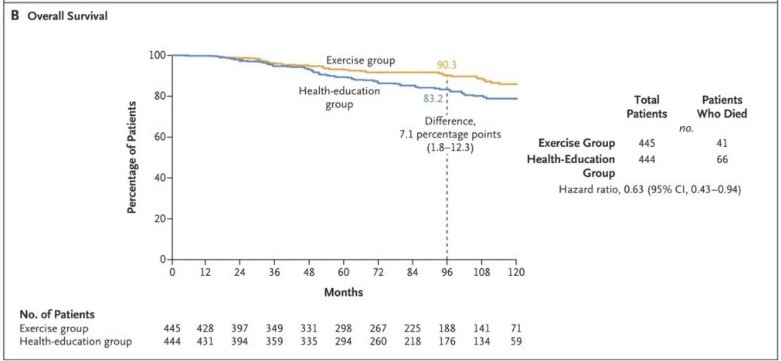Fitness is the Future of Healthcare
Muscle-Promoting Therapeutics, Cold Plunges, VO2max Testing, Lifestyle Medicine, and Longevity: All Trends Point to Fitness
With my background as a kinesiology major and personal trainer, I was surprised by how little attention fitness received in medical school or the hospital.
During my MD and PhD training, I saw firsthand that most physicians knew very little about fitness—and that academic funding for exercise science was almost nonexistent. Less than 1% of NIH funding goes toward physical activity research. Even when I received a 14th percentile score on my F30 grant—at an institute with a 28th percentile funding cutoff—to study how exercise slows cancer growth, the grant was never awarded.
In clinical practice, it was rare to hear a physician talk about exercise with patients. Despite clear guidelines recommending lifestyle changes—like physical activity and reduced calorie intake—as first-line treatment for many chronic diseases, the focus almost always defaulted to medications. Which I don’t blame them because we didn’t learn how to do that in medical school patient interview simulations.
However, several powerful trends now make it overwhelmingly clear: the future of healthcare is fitness. And it’s no longer just the domain of gym bros.
Fitness as an Endpoint of Pharmaceutical Development
One of the clearest signs that fitness isn’t going anywhere is the pharmaceutical industry’s growing focus on fitness-related endpoints. It’s no longer “therapeutics instead of exercise”—it’s therapeutics inspired by the mechanistic benefits of exercise. (Turns out my PhD was just a few years ahead of its time.)
Just today, Eli Lilly committed up to $650 million to Juvena Therapeutics for a drug aimed at promoting “muscle health.”
““We are thrilled … [about the] transformative potential that promote healthspan in individuals facing chronic conditions like obesity and frailty,” said Dr. Hanadie Yousef, co-founder and CEO of Juvena Therapeutics. “Particularly as a strong body of evidence demonstrates the link between muscle health and enhanced metabolism, mobility, and even long-term disease prevention and overall health”
Outside of vaccines, it’s been exceedingly rare for drugs to be positioned in the context of prevention and health promotion—until now.
We’ve moved beyond testosterone and Olympic weightlifters. Today, myostatin inhibitors and other muscle-building pathways are getting serious attention, catalyzed by the formal classification of obesity as a treatable condition.
It won’t be long before we see drugs developed specifically to boost VO₂ max—even in the absence of disease.
Longevity Movement Pushing the Boundaries of Healthspan
Whether it’s a VO₂ max test, methylene blue, or sober “Coffee & Chill” cold plunges in metropolitan cities, the booming longevity movement is getting people to talk about—and invest in—healthspan. People don’t just want to live longer; they want to feel what it means to be healthy. While the science behind some of these frontier interventions is still catching up, one thing is clear: the public discourse around health is shifting.
Exercise as Medicine Goes Mainstream
A recent randomized controlled trial published in The New England Journal of Medicine showed that a structured exercise program improves survival in cancer survivors—a landmark validation of movement as medicine.
At the same time, the popularity of figures like Andrew Huberman, Peter Attia, and Eric Topol reflects a cultural shift: science-backed lifestyle medicine is going mainstream. These voices aren’t just promoting fitness, nutrition, and sleep—they’re translating cutting-edge research into actionable habits for the public. And people are listening.
Necessary Infrastructure for the Emerging Fitness-Oriented Healthcare Industry
Biomarkers that define health and fitness: Whether used to quantify the effects of lifestyle interventions or pharmaceutical ones, a new class of diagnostics will be required. To promote healthspan—and secure reimbursement—we need to define what health looks like in the absence of disease. These biomarkers will form the foundation of both prevention-focused care and personalized therapeutic development.
Integrated medical fitness centers: Primary care will increasingly resemble a hybrid of community center, gym, and wellness clinic—with a phlebotomist down the hall. While the traditional sick-care hospital system will persist, the default for prevention and health promotion will be a new kind of clinic: one rooted in movement, measurement, and behavior change. The Medical Fitness Association, founded in 1991, has laid the groundwork for this model—but what comes next will be more integrated, more tech-enabled, and far more scalable.
Reimbursement Pathways for Structured Exercise Protocols: Insurance already covers nutrition counseling and rehabilitation for patients who are sick or recovering from surgery. But true prevention requires coverage before disease manifests. Structured exercise and nutritional interventions must be reimbursable as first-line therapies—not just reactive afterthoughts.
How are you improving your fitness these days?







It is really important to understand the importance of living a healthy life, and the recent trend towards developing a healthy lifestyle is a really positive trend.
I walk every day to work and back. It has significantly improved my sleep, and that in itself solves a lot of problems.
The infrastructure you mention are great concepts on which to build a consortium and then seek funding for a big projects to make them happen.